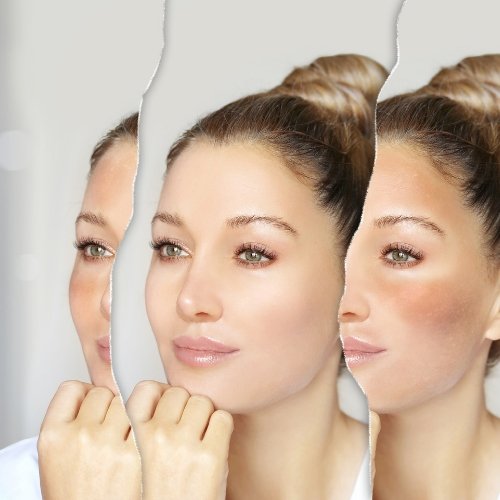
Hormonal pigmentation or Melasma as it is often called, is a type of hyperpigmentation which can be a very stubborn and frustrating skin concern that can develop during hormonal changes in life. Hyperpigmentation is an umbrella term to describe an area of skin which develops more melanin, resulting in patchy, discoloured skin that often looks like a misshapen freckle or small birthmark. It is a relatively common skin condition however one that can cause a lot of distress. Hormonal pigmentation on the face often shows up on the forehead, upper cheeks, around the eyes and around the mouth.
What causes Hormonal Pigmentation?
It can seemingly pop up out of nowhere but it is often caused by a fluctuation of hormones such as during pregnancy, menopause or from the contraceptive pill. Also when taking certain medications or just a genetic predisposition! It will sometimes disappear on its own, for example after pregnancy, but it can also be very stubborn and both men and women find it can be difficult to get rid of.
Other types of hyperpigmentation:
There are several different types of hyperpigmentation other than hormonal, with the same resulting dark patches or spots.
ACNE PIGMENTATION
Post inflammatory hyperpigmentation is formed after a skin injury or inflammation, for example pigmentation from acne or blemishes, scars, cuts or burns. These are the easiest to fade, but in saying that, they still can take months to fully disappear.
SUN PIGMENTATION
Sunspots are, you guessed it, caused by sun exposure. These often occur on areas of the skin that see a lot of sun like shoulders, hands, forehead and cheeks and this is the most common type of hyperpigmentation.
5 best Hormonal Pigmentation products in Australia 2022.
La Clinica’s range of pigmentation-fighting and complexion-brightening products are specially formulated to help reduce the appearance of dark spots. Carefully chosen ingredients with proven clinical data will help you on the way to a more even complexion and clarified skin.
THE BRIGHTENING SERUM - LEVEL 2
Our newest, most potent treatment is the Brightening Serum Level 2 with Alpha-Arbutin, a relatively new player in the readily-available skincare game. Alpha-Arbutin is an antioxidant backed by research to fade discolouration and even out skin tone. It inhibits the formation of melanin on the skin by blocking tyrosinase, the enzyme that produces dark spots. It also includes Tranexamic Acid, another hot ingredient that the beauty sphere is raving about. Clinical studies using Tranexamic Acid have found stand-out results in reduction of melasma / hormonal pigmentation. The reason this is so exciting is that melasma is notoriously hard to treat and frequently recurs. Boosted with Niacinamide, Vitamin C, Mulberry & Licorice Root Extracts for extra brightening power, this level 2 serum really packs a punch.
FEATURES OF THE BRIGHTENING SERUM LEVEL 2
- Contains powerful, pigmentation-fighting Alpha-Arbutin and Tranexamic Acid
- Also includes Vit C, Niacinamide, Mulberry & Licorice Root Extracts
- A silky, light, everyday serum
- A favourite product of skincare scientist and influencer Hannah English
THE BRIGHTENING MOISTURE CREAM
The Brightening Moisture Cream contains a powerful dosage of Sabiwhite, an antioxidant that works to slow down melanogenesis, which is the production of the melanin pigments. It helps to lighten discoloration, provides UVB and antioxidant protection and is also anti-inflammatory. It also helps to even out skin tone, texture and give the skin luminosity.
FEATURES OF THE BRIGHTENING MOISTURE CREAM
- Contains Sabiwhite
- Lightweight and easily absorbed
- Perfect for daily use
VITAMIN C SERUM FOR PIGMENTATION
Our Vitamin C Ultra Serum helps to brighten skin’s appearance. A powerful antioxidant, Vitamin C not only helps reduce the appearance of hormonal pigmentation or pigmentation from acne, but also helps fight against external stressors such as UV rays and free radicals that can swindle your skin out of its natural radiance.
FEATURES OF THE VITAMIN C ULTRA SERUM
- Contains 3 types of Vitamin C
- Also contains Vitamin E and Hyaluronic Acid
- Easily tolerated by all skin types
- Also protects against environmental stressors
RETINOL FOR PIGMENTATION
Want to fight the signs of ageing at the same time as hormonal pigmentation? Retinol may be the product of choice for you. New to the world of retinol? Just remember to only use it at night and it won’t do a thing if you’re not using sunscreen every day.
FEATURES OF RETINOL
- Turns over skin cells
- Encourages collagen production
- Smooths discolouration
- Evens out skin tone
HOW TO PREVENT PIGMENTATION IN 2022
Prevention is important for avoiding pigmentation! Sunscreen all day, every day. And top up if possible. Proper suncare is always important regardless of whether you’re concerned about hyperpigmentation. It also prevents premature ageing such as the formation of fine lines and wrinkles and of course it protects you against skin cancer. As the old saying goes, if you’re not using sunscreen, you’re wasting your time (and money!) on all other products.
PREVENTING PIGMENTATION CAUSED BY ACNE OR BLEMISHES
Keep sticky fingers from picking any pimples on your face to reduce inflammation, causing pigmentation from acne or cause any larger injury which can lead to scarring. It’s hard to resist giving those breakouts a good old squeeze so instead, spot treat with the Intensive Spot Serum which provides calming and anti-inflammatory properties to help you resist picking and help reduce the life of the pimple at the same time.
HEALING PIGMENTATION
It is also important to help your skin heal. Try the Hydrating and Healing Serum to give your skin the best possible path to smooth, healthy skin. Formulated to help skin maximise hydration, assist in skin recovery and encourage faster healing.
The final word on preventing Hormonal Pigmentation
Be patient! Pigmentation is a pesky one and likes to stick around. Whether it be hormonal pigmentation, pigmentation from acne or sun induced discolouration, the active ingredients you apply to the skin take time and regular use to work, at least 6 weeks.


